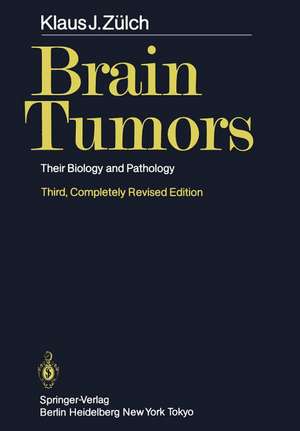Brain Tumors: Their Biology and Pathology
Autor K. J. Zülch Prefață de P. Bailey Traducere de A. B. Rothballer, J. Olszewskien Limba Engleză Paperback – 7 dec 2011
Preț: 744.62 lei
Preț vechi: 783.80 lei
-5% Nou
Puncte Express: 1117
Preț estimativ în valută:
142.50€ • 154.73$ • 119.70£
142.50€ • 154.73$ • 119.70£
Carte tipărită la comandă
Livrare economică 22 aprilie-06 mai
Preluare comenzi: 021 569.72.76
Specificații
ISBN-13: 9783642681806
ISBN-10: 3642681808
Pagini: 724
Ilustrații: XVIII, 706 p.
Dimensiuni: 170 x 244 x 38 mm
Greutate: 1.13 kg
Ediția:3rd ed. 1986. Softcover reprint of the original 3rd ed. 1986
Editura: Springer Berlin, Heidelberg
Colecția Springer
Locul publicării:Berlin, Heidelberg, Germany
ISBN-10: 3642681808
Pagini: 724
Ilustrații: XVIII, 706 p.
Dimensiuni: 170 x 244 x 38 mm
Greutate: 1.13 kg
Ediția:3rd ed. 1986. Softcover reprint of the original 3rd ed. 1986
Editura: Springer Berlin, Heidelberg
Colecția Springer
Locul publicării:Berlin, Heidelberg, Germany
Public țintă
ResearchCuprins
1 Classification of Brain Tumors.- 1.1 Introduction.- 1.2 Historical Development and Present State of Classification.- 1.3 The Basis of Our Present Classification: The Classification of the World Health Organization.- 1.4 Critical Evaluation of the Present State of Classification of Tumors of the Nervous System.- 2 Biological Behavior and Grading (Prognosis).- 2.1 Malignancy — Anaplasia — Dedifferentiation.- 2.1.1 Definition of Benignity and Malignancy.- 2.1.2 Other Characteristics of Anaplasia and Malignancy.- 2.2 Prognosis — Biological Evaluation — Postoperative Survival Time– The Problem of Grading.- 2.2.1 Clinical Malignancy.- 2.2.2 Tumor Groups With Identical Histology and Similar Location, Age and Sex.- 2.2.3 Statistical Data on the Postoperative Survival of Patients.- 2.2.4 The Problem of Grading.- 3 The Origin of Brain Tumors.- 3.1 Current Concepts.- 3.2 Experimental Brain Tumors (Carcinogenic Substances — Viral Induction — Others).- 3.3 Hereditary Factors.- 3.3.1 Tumors in Twins.- 3.3.2 Familial and Hereditary Brain Tumors.- 3.3.3 Familial Systematic Hamartoblastomatoses (Phakomatoses).- 3.3.3.1 Neurofibromatosis.- 3.3.3.2 Tuberous Sclerosis.- 3.3.3.3 Systematic Angiomatosis of the CNS and Eye (von Hippel-Lindau Disease).- 3.3.3.4 Sturge-Weber Disease.- 3.4 Traumatic Brain Tumors.- 3.5 “Composition” and “Mixed” Tumors.- 3.6 Transplantability of Human Brain Tumors — Immunological Aspects.- 3.7 Spontaneous Brain Tumors in Animals.- 4 Epidemiology of Brain Tumors — General Statistical and Biological Data.- 4.1 Age Incidence.- 4.2 Sex Distribution of Patients With Brain Tumors.- 4.3 Frequency.- 4.4 Preferential Sites of Brain Tumors.- 4.5 Diffuse and Multiple Brain Tumors.- 5 Gross Pathology of Brain Tumors.- 5.1 The Process of TumorDiagnosis.- 5.2 Form, Color, Consistency, and Appearance to the Naked Eye.- 6 Histology of Brain Tumors.- 6.1 Architecture and Cell Formation.- 6.2 The Problem of Iso- and Pleomorphism.- 6.3 Nuclei of the Cells.- 6.4 Stroma.- 6.5 Growth.- 6.6 Form and Staining Properties of Tumor Cells.- 7 Regressive Processes.- 7.1 Necrosis.- 7.2 Necrobiosis, Mucoid Degeneration, Cyst Formation, Calcification, Hyalinization, and Fatty Degeneration.- 7.3 Hemorrhages.- 7.4 Other Regressive Processes.- 8 Changes Produced by External Factors Such as Radiation.- 9 Effects of Chemotherapy.- 10 Tumor and Brain.- 10.1 Reactions of the Surrounding Tissue.- 10.2 Brain Edema and Brain Swelling.- 10.3 Increased Intracranial Pressure and its Consequences: Mechanical Distortion and Displacement of Intracranial Contents (Mass Movement and Herniation).- 10.4 Cytology of the Cerebrospinal Fluid With Brain Tumors.- 11 Spontaneous Intra- and Extracranial Metastases of Brain Tumors in Man — Artificial Seeding.- 12 Postoperative Recurrence.- 13 Methods of Pathological Study.- 13.1 Cytopathology.- 13.2 Histochemistry.- 13.3 Tissue Culture.- 13.4 Electron Microscopy.- 13.5 Protein Analysis.- 13.6 Quick Diagnosis.- 13.6.1 Smear Technique.- 13.6.2 Quick Frozen Section.- 14 Autopsy Techniques.- 14.1 General Introduction.- 14.2 Fixation.- 14.3 Brain Cutting.- 14.4 Routine Histologic Examination.- 14.5 Selection of Stains for Special Tissues.- 14.6 Selection of Stains for Particular Tumor Groups.- 15 Tumors of Neuroepithelial Tissue.- 15.1 Astrocytic Tumors.- 15.1.1 Astrocytomas.- 15.1.2 Pilocytic Astrocytomas.- 15.1.3 Subependymal Giant Cell Astrocytomas (Ventricular Tumors of Tuberous Sclerosis).- 15.1.4 Astroblastomas.- 15.1.5 Anaplastic (Malignant) Astrocytomas.- 15.2 Oligodendroglial Tumors.- 15.2.1Oligodendrogliomas.- 15.2.2 Mixed Oligo-Astrocytomas.- 15.2.3 Anaplastic (Malignant) Oligodendrogliomas.- 15.3 Ependymal and Choroid Plexus Tumors.- 15.3.1 Ependymomas.- 15.3.1.1 Myxopapillary Ependymomas.- 15.3.1.2 Papillary Ependymomas.- 15.3.1.3 Subependymomas.- 15.3.2 Anaplastic Ependymomas.- 15.3.3 Choroid Plexus Papillomas.- 15.3.4 Anaplastic Choroid Plexus Papillomas.- 15.4 Pineal Cell Tumors.- 15.4.1 Pineocytomas.- 15.4.2 Pineoblastomas.- 15.4.3 Pinealomas.- 15.4.4 Suprasellar (Ectopic) Pinealomas/Germinomas.- 15.5 Neuronal Tumors.- 15.5.1 Gangliocytomas.- 15.5.2 Gangliogliomas.- 15.5.3 Ganglioneuroblastomas.- 15.5.4 Anaplastic (Malignant) Gangliocytomas/Gangliogliomas.- 15.5.5 Neuroblastomas — Retinoblastomas — Sympathoblastomas.- 15.6 Poorly Differentiated and Embryonal Tumors.- 15.6.1 Glioblastomas.- 15.6.1.1 Glioblastomas With Sarcomatous Component.- 15.6.1.2 Giant Cell Glioblastomas.- 15.6.2 Medulloblastomas.- 15.6.2.1 Desmoplastic Medulloblastomas.- 15.6.2.2 Medullomyoblastomas.- 15.6.3 Medulloepitheliomas.- 15.6.4 Primitive Polar Spongioblastomas.- 15.6.5 Gliomatosis Cerebri.- 16 Tumors of Nerve Sheath Cells.- 16.1 Neurilemmomas.- 16.2 Anaplastic (Malignant) Neurilemmomas.- 16.3 Neurofibromas.- 16.4 Anaplastic (Malignant) Neurofibromas.- 17 Tumors of Meningeal and Related Tissues.- 17.1 Meningiomas.- 17.1.1 Meningotheliomatous Meningiomas.- 17.1.2 Fibrous (Fibroblastic) Meningiomas.- 17.1.3 Transitional (Mixed) Meningiomas.- 17.1.4 Psammomatous Meningiomas.- 17.1.5 Angiomatous Meningiomas.- 17.1.6 Papillary Meningiomas.- 17.1.7 Anaplastic (Malignant) Meningiomas.- 17.1.8 Melanocytic Meningiomas.- 17.2 Meningeal Sarcomas.- 17.2.1 Fibrosarcomas.- 17.2.2 Polymorphic Cell Sarcomas.- 17.2.3 Primary Meningeal Sarcomatosis (Diffuse Sarcomatosis of theMeninges).- 17.2.4 Circumscribed Arachnoidal Sarcomas of the Cerebellum.- 17.2.5 Rhabdomyosarcomas.- 17.3 Xanthomatous Tumors: Fibroxanthoma — Xanthosarcoma (Malignant Fibroxanthoma).- 17.4 Primary Melanotic Tumors: Melanomas and Meningeal Melanomatosis.- 17.5 Others.- 18 Primary Malignant Lymphomas.- 18.1 Primary Tumors of the Lymphoreticular System.- 18.1.1 Reticulum Cell Sarcomas.- 18.1.2 Adventitial Sarcomas.- 18.1.3 Hodgkin’s Disease.- 18.1.4 Plasmocytomas.- 18.1.5 Histiocytosis X.- 18.1.6 Eosinophilic Granuloma (of Bone).- 18.1.7 Burkitt’s Lymphoma (African Lymphoma).- 19 Tumors of Blood Vessel Origin.- 19.1 Hemangioblastomas.- 19.2 Monstrocellular Sarcomas.- 20 Germ Cell Tumors.- 20.1 Germinomas.- 20.2 Embryonal Carcinomas.- 20.3 Choriocarcinomas.- 20.4 Teratomas.- 21 Other Malformative Tumors and Tumor-Like Lesions.- 21.1 Craniopharyngiomas.- 21.2 Rathke’s Cleft Cysts.- 21.3 Epidermoid and Dermoid Cysts.- 21.4 Colloid Cysts.- 21.5 Enterogenous Cysts.- 21.6 Other Cysts (“Ependymal Cysts”).- 21.7 Lipomas.- 21.8 Choristomas.- 21.9 Hypothalamic Neuronal Hamartomas.- 21.10 Nasal Glial Heterotopias.- 22 Vascular Malformations.- 22.1 Capillary Teleangiectasia (Angioma Racemosum Capillare Ectaticum).- 22.2 Cavernous Angiomas.- 22.3 Arteriovenous Malformations.- 22.4 Venous Malformations (Angioma Venosum).- 22.5 Sturge-Weber Disease.- 22.6 Cryptic Malformations (Microangiomas).- 22.7 Moya-Moya Disease.- 23 Tumors of the Anterior Pituitary.- 23.1 Pituitary Adenomas.- 23.2 Pituitary Adenocarcinomas (Carcinoma of the Anterior Pituitary Cells).- 24 Local Extensions From Regional Tumors.- 24.1 Glomus Jugulare Tumors.- 24.2 Chordomas.- 24.3 Chondromas.- 24.4 Chondrosarcomas — Mesenchymal Chondrosarcomas.- 24.5 Liposarcomas.- 24.6 Olfactory Neuroblastomas(Esthesioneuroblastomas).- 24.7 Adenoid Cystic Carcinomas.- 24.8 Others.- 24.8.1 Osteomas.- 24.8.2 Osteosarcomas.- 24.8.3 Nasopharyngeal Tumors.- 25 Metastatic Tumors.- 26 Unclassified Tumors.- 27 Parasitic Conditions.- 27.1 Cysticercosis.- 27.2 Echinococcosis.- 27.3 Others.- 28 Granulomas.- 28.1 Tuberculomas.- 28.2 Gummas.- 28.3 Other Granulomas.- 28.4 Mycotic (Fungal) Infections.- 29 Arachnoiditis and Arachnoid Cysts.- 30 Ependymitis — Ependymal Cysts.- 31 “Pseudotumor Cerebri”.- 32 Tumors of the Spinal Cord, the Cauda Equina, and the Vertebral Column.- 33 The Orbit: Space-Occupying Lesions.- References.










